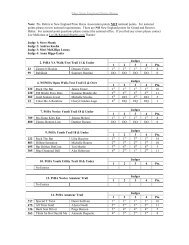2011 Official Rule Book - New England Pinto Horse Association
2011 Official Rule Book - New England Pinto Horse Association
2011 Official Rule Book - New England Pinto Horse Association
You also want an ePaper? Increase the reach of your titles
YUMPU automatically turns print PDFs into web optimized ePapers that Google loves.
ClassEs<br />
is performed with great style, elegance and airiness of<br />
motion. A flat footed walk is not to be penalized.<br />
2. Trot: Natural, animated and cadenced, bold, with power<br />
from behind but the front light and airy, a true two beat gait.<br />
3. Canter: True, collected, smooth and unhurried three beat<br />
gait; straight on both legs.<br />
C. Judging<br />
1. Faults would include: rough, short, or labored action;<br />
leaning or lugging on the bit; poll not above withers;<br />
excessive speed; crooked or sideways movement;<br />
excessive action in one gait or uneven action from gait to<br />
gait; exaggerated, artificial, or unnatural appearing action.<br />
2. To be judged on performance, presence, quality,<br />
conformation, manners and suitability.<br />
n8. Three-Gaited<br />
A. General Regulations<br />
1. Entries to give a brilliant performance, with style, presence,<br />
finish, balance and cadence. To enter the ring at a trot.<br />
Class may not be pre-loaded.<br />
2. All entries must conform to the Saddle type regulations<br />
concerning hooves, manes and tails, and braids. Nonconforming<br />
entries must be eliminated.<br />
3. This class may be combined with Park <strong>Horse</strong> class.<br />
4. Entries are required to walk prior to execution of change of<br />
gait or reverse.<br />
5. Entries not to back.<br />
B. Gaits<br />
1. To be shown at an animated and graceful walk, an<br />
animated trot and canter. All gaits to be performed in<br />
collected balance with high action, brilliance and presence<br />
both ways of the ring. High head carriage and great<br />
elevation of knees and hocks are normal. Knee flexion<br />
should be proportionate to hock flexion. The animal’s<br />
energy should be directed toward animation rather than<br />
speed.<br />
a. Walk: The animated walk is a highly collected gait,<br />
exhibiting much “primp” at a slow, regulated speed,<br />
with good action and animation. It should have snap<br />
and easy control. It can either be a two beat or four<br />
beat gait. It is performed with great style, elegance<br />
and airiness of motion. A flat footed walk is not to be<br />
penalized.<br />
b. Trot: Highly collected, straight, two beat gait.<br />
c. Canter: Slow, lofty and fluid, with definite three beat<br />
cadence, consistent rate of speed.<br />
C. Judging<br />
1. Faults would include: rough, short or low action, leaning<br />
or lugging on the bit, mixing gaits, or tendency to pace;<br />
dragging hocks; unbalanced action; loss of form due to<br />
excessive speed.<br />
2. To be judged on performance, presence, quality, manners,<br />
conformation and suitability.<br />
3. To be shown at an animated and graceful walk, an animated<br />
trot and canter, both ways of the ring.<br />
n9. Five-Gaited<br />
A. General Regulations<br />
1. Entries to give a brilliant performance, with style, presence,<br />
finish, balance and cadence. All gaits shall be executed with<br />
high, balanced action and no loss of form. To enter the ring<br />
at a trot. This class may not be pre-loaded.<br />
2. This class shall be covered by the Saddle type regulations<br />
concerning hooves, manes and tails, and braids, except<br />
154 <strong>2011</strong> PtHA <strong>Rule</strong> <strong>Book</strong>



